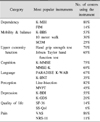1. Potter K, Fulk GD, Salem Y, Sullivan J. Outcome measures in neurological physical therapy practice: part I. Making sound decisions. J Neurol Phys Ther. 2011. 35:57–64.
2. Wade DT. Evidence relating to goal-planning in rehabilitation. Clin Rehabil. 1998. 12:273–275.
3. Barak S, Duncan PW. Issues in selecting outcome measures to assess functional recovery after stroke. NeuroRx. 2006. 3:505–524.
4. Skinner A, Turner-Stokes L. The use of standardized outcome measures in rehabilitation centers in the UK. Clin Rehabil. 2006. 20:609–615.
5. Shah S, Vanklay F, Cooper B. Improving the sensitivity of the Barthel Index for stroke rehabilitation. J Clin Epidemiol. 1989. 42:703–709.
6. Jung HY, Park BK, Shin HS, Kang YK, Pyun SB, Paik NJ, Kim SH, Han TR. Development of the Korean version of Modified Barthel Index (K-MBI): multi-center study for subjects with stroke. J Korean Acad Rehabil Med. 2007. 31:283–297.
7. Lee JJ, Lee HJ, Jung HY. The Korean version of Berg balance scale as an index of activity related to ambulation in subjects with stroke. J Korean Acad Rehabil Med. 2007. 31:400–403.
8. Berg KO, Wood-Dauphine'e SL, Williams JI, Maki B. Measuring balance in the elderly: validation of an instrument. Can J Public Health. 1992. 83:Suppl 2. S7–S11.
9. Jung HY, Park JH, Shim JJ, Kim MJ, Hwang MR, Kim SH. Reliability test of Korean version of Berg balance scale. J Korean Acad Rehabil Med. 2006. 30:611–618.
10. Harvan JR, Cotter V. An evaluation of dementia screening in the primary care setting. J Am Acad Nurse Pract. 2006. 18:351–360.
11. Gorp WG, Marcotte TD, Sultzer D, Hinkin C, Mahler M, Cummings JL. Screening for dementia: comparison of three commonly used instruments. J Clin Exp Neuropsychol. 1999. 21:29–38.
12. Shin MH, Lee YM, Park JM, Kang CJ, Lee BD, Moon E, Chung YI. A combination of the Korean version of the mini-mental state examination and Korean dementia screening questionnaire is a good screening tool for dementia in the elderly. Psychiatry Investig. 2011. 8:348–353.
13. Kim H, Na DL. Normative data on the Korean version of the Western Aphasia Battery. J Clin Exp Neuropsychol. 2004. 26:1011–1120.
14. Lee KJ, Lee CJ, Kim JH, Jung SM. Concurrent validity of the Korean test for the differential diagnosis of aphasia. Korean J Commun Disord. 2009. 14:58–69.
15. Wilde MC. The validity of the repeatable battery of neuropsychological status in acute stroke. Clin Neuropsychol. 2006. 20:702–715.
16. Pierce CA, Jewell G, Mennemeier M. Are psycholphysical functions derived from line bisection reliable? J Int Neuropsychol Soc. 2003. 9:72–78.
17. Aben I, Verhey F, Lousberg R, Lodder J, Honig A. Validity of the Beck depression inventory, hospital anxiety and depression scale, SCL-90, and Hamilton depression rating scale as screening instruments for depression in stroke patients. Psychosomatics. 2002. 43:386–393.
18. Rhee MK, Lee YH, Park SH, Shon CH, Chung YJ. A standardization Study of Beck Depression Inventory 1 - Korean version (K-BDI): reliability and factor analysis. Korean J Psychopathol. 1995. 4:77–95.
19. Kim KT, Ahn JD, Lee HI, Ahn CB. Reliability and validity of modified visual analogue scale for measuring pain. J Korean Assoc Pain Med. 2003. 2:75–80.





 PDF
PDF ePub
ePub Citation
Citation Print
Print




 XML Download
XML Download